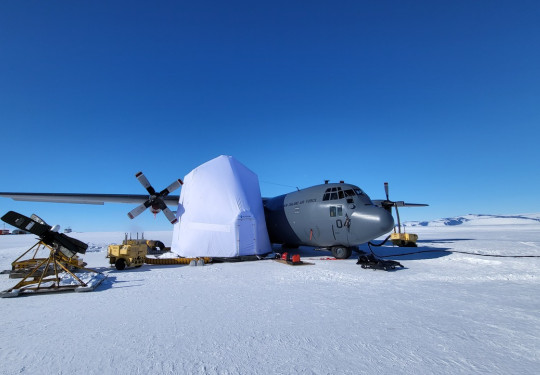Recovery from the ice
Suffering a maintenance problem on the icy runways of Antarctica is not ideal. But when a major propeller fault on a C-130 Hercules aircraft recently occurred, a dedicated team of maintainers flew to the frozen continent to fix it in sub-zero temperatures
29 November, 2022
With Prime Minister Jacinda Ardern on board, the aircraft was starting-up to return home following the 65th anniversary of Scott Base. After starting number three engine, a significant hydraulic leak from the propeller was identified by crew, followed immediately by smoke inside the aircraft which was quickly isolated. After shutting down and investigating, it was determined the only suitable rectification option was to replace the whole propeller assembly.
Once news of the required maintenance to recover the aircraft had reached No. 40 Squadron Maintenance, a team immediately started preparing for the task, identifying required spares, tools, skill-sets and qualifications. Within 36 hours of the initial notification, a team of nine maintenance staff flew to Christchurch with all their equipment, ready for the next available flight to Antarctica on a United States Air Force C-17 the following day.
Changing a C-130H propeller is a big job at the best of times, but when you add extreme cold (averaging -17C ambient and -29C wind chill), icy surfaces, wearing ski goggles, limited equipment and communication, the task becomes significantly more challenging. These human factors all stacked-up to make the risk of error or accident much higher than usual, which needed to be actively managed by the whole team involved.
Over the four days following the arrival in Antarctica the faulty propeller was removed, a replacement installed and all rigging checks completed on the ice apron of Phoenix Airfield.
The team worked closely with the New York Air National Guard, who maintain LC-130H Hercules at Williams Field in Antarctica. They provided a range of essential equipment, contacts and valuable first-hand experience with Antarctic aircraft maintenance and engine ground running operations.
“With logistics support from McMurdo Station, the 109th New York Air National Guard and Scott Base, the team successfully changed the propeller, completed functional checks and safely recovered the aircraft back to New Zealand,” engineering officer Flight Lieutenant (FLTLT) Dan Lamb said.
The task was also helped by the use of an ice shelter, purchased this year through the Capability Management Framework, which was inflated using a generator borrowed from Scott Base. The ice shelter provided essential protection from the brutally cold conditions, allowing propeller installation and rigging to progress far quicker than what would have otherwise been possible.
Three days after work began on the propeller, aircrew arrived and engine ground runs started the next day; with no aircraft towing equipment on the ice the aircraft had to be taxied to engine running locations. Over the following days iterations of engine runs and further maintenance were undertaken before the aircraft was able to fly back to Aotearoa New Zealand, 11 days after the propeller failed.
“Solid planning from the team identified all elements required to complete the whole task safely from the start – important for such remote work,” FLTLT Lamb said.
“I think it’s easy to underappreciate huge spread of assets, people from a range of agencies, aircrew and maintenance teams, all working together to make this happen. I’m incredibly proud of our maintenance team, which tackled the environment and all its challenges like champs; getting the job done while making the most of this unique experience.”
